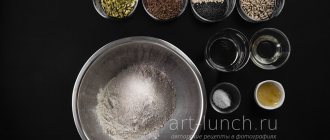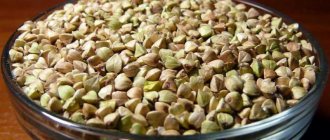Funchoza is starch noodles. It is also called “glass”. This is a native Asian dish that is very popular in China, Japan and Korea.
Noodles are prepared from legume starch, canna, potato, corn or cassava. The product is completely tasteless and odorless. However, during the cooking process, the noodles quickly acquire other smells and tastes from sauces and other seasonings.
| Calories per 100 g, (kcal): | 320 |
| Protein per 100 g, (g): | 0.7 |
| Fat per 100 g, (g): | 0.5 |
| Carbohydrates per 100 g, (g): | 84 |
| Glycemic index: | 45 |
What are glass noodles made from?
The existing opinion that funchose is prepared only from rice flour is not true! Real Asian glass noodles are made from the starch of plants such as:
- cassava,
- canna rhizomes,
- beans,
- quinoa,
- other starchy plants.
It can also be prepared from rice and potatoes, certainly with the addition of zinc and aluminum, it is impossible without them. Is it true that you immediately lose the desire to even look at the funchose on the shelf in the supermarket? But this does not mean that glass noodles are only beneficial or only harmful. Let's figure it out.
About starch
Without understanding what starch is, it is impossible to understand the beneficial and harmful properties that funchose contains, because it is made from it. Starch is one of the types of complex carbohydrates.
This is a natural substance found only in plants. However, different starch products are digested differently. Potato starch, for example, has a high digestion rate, while bean and rice starch have a low digestion rate. The digestibility of starchy substances also depends on the processing method.
But there is also so-called resistant starch, the digestibility of which is zero. Glass noodles contain resistant starch in a proportion of 10-20% of the total amount of carbohydrates and healthy starches, if they are prepared without violations associated with the desire of the seller to reduce the cost of the product. It must be said that the desire to optimize production costs is international, and people in the East and West are the same.
Resistant or resistant starch is insoluble, does not transform into glucose, which is important for diabetes, but settles in the large intestine and feeds a huge army of bacteria. This is a useful process called fermentation. The processing of starch by bacteria leads to the saturation of the body with fatty acids, in addition, the intestinal walls are strengthened, preventing the formation of cancer cells. The fermentation process of resistant starches stimulates the absorption of minerals into the walls of blood vessels, calcium and magnesium are more easily absorbed, and blood glucose, blood fat, and cholesterol levels decrease. Emptying occurs more easily, becomes regular, and the feeling of satiety that occurs almost immediately eliminates such an urgent problem as calorie content, which is dangerous for weight loss.
There is much debate about which cooking method retains the optimal amount of resistant starch. Points of view are divided into directly opposite ones, despite the fact that oriental cooks invented funchose at the beginning of the 19th century and included it in the diet on a regular basis, understanding its beneficial properties and understanding nothing about diabetes, oncology and other diseases of the 20th century.
Funchoza for weight loss
Glass noodles have no taste, but perfectly absorb the tastes and aromas of other products, therefore, we can confidently say that funchoza is one of the best side dishes on the planet. In addition, this champion of side dishes, whose calorie content is quite high (320 Kcal), is indicated for people to lose weight.
The calorie content of a product is not the most important thing; its composition is much more important. Funchoza is rich in B vitamins, and they are responsible for the efficiency of metabolic processes in the body, which is important for weight loss. To this we must add the absence of gluten in glass noodles. This is an extremely complex protein that causes inflammation and a lot of troubles that slow down the process of food digestion, what kind of weight loss is there?
Thus, high calorie content is not an obstacle to including funchose in the diet for weight loss. Glass noodles help older people eat right, stay cheerful, and have confidence in the future; by the way, for them, the high calorie content of foods is not a hindrance in principle, especially with diabetes, oncology, and cardiovascular diseases.
Beneficial features
It is clear that the product, born of Eastern wisdom, has a lot of useful properties. Deposits of vitamin “B” of all types were mentioned above; it remains to add that funchose is a storehouse of vitamins and minerals. It contains tocopherol, thiamine, riboflavin, nicotine, folic acid, phosphorus, sodium, potassium, magnesium and many others. Its high calorie content is also valuable.
Glass noodles need to be eaten to improve:
- activity of the nervous system, it is an excellent antidepressant,
- skin structure, activation of metabolic processes in it,
- maintaining youth and health of the body,
- lowering glucose levels in diabetes mellitus,
- cancer prevention,
- eliminating the risk of vascular diseases, thrombophlebitis,
- improving intestinal motility and digestion.
This is not a complete list of the beneficial properties of funchose. The powerful vitamin and mineral composition of the product is especially necessary for energy metabolism, antioxidant protection, normalization of cellular nutrition, stabilization of blood sugar levels in diabetes, and more.
Harm and contraindications
Glass noodles have virtually no contraindications, of course, if we are talking about the right funchose made from quality ingredients. Overeating should not be allowed, it is harmful even with diabetes and other diseases for which the inclusion of funchose in the diet is beneficial. We must also not forget about individual intolerance to the product. However, funchoza does not know such cases.
Video about the benefits and harms of funchose
Recently, funchose - rice noodles, as many people who do not know the true composition of this “glass” noodles are used to calling them, has become popular. This product came to Russia from Asian countries relatively recently. In its homeland, the product has a well-deserved reputation - noodles occupy one of the first places in cooking and are almost the main dish on the table.
Funchoza is a starchy noodle, the starch for which is previously extracted from rice. This is a traditional recipe, but nowadays rice starch is replaced by the main ingredient of legumes, corn, potatoes and starchy plants native to Asian countries - mung and cassava. Such noodles differ from rice noodles not only in composition, but also in appearance.
Real funchose has a translucent appearance and does not change after cooking, while rice noodles become whiter when cooked. Funchoza can be a separate dish or used as an ingredient in salads and soups. The dishes are traditionally served with sweet and sour sauce or different variations of seasonings.
The product tastes impeccable both hot and cold. Funchoza, the benefits and harms of which are determined by its chemical composition, is the main ingredient in Eastern countries.
Reviews
Svetlana, 36 years old: If you don’t like funchose, it means you simply don’t know how to cook it. This is simply a treasure for lovers of beauty. Firstly, it is easier to prepare than rollton, and secondly, it is much tastier and healthier than it. I exaggerated a little about the taste, because it is neutral, but any spices, sauces, or additives can be suitable. It perfectly reflects the taste of soy sauce.
I like to eat glass pasta with shrimp, sprinkled with cheese and herbs. If you tried it and didn't like it, try making it yourself at home again. And for those who have never eaten this “glass” before, I strongly recommend trying it. After it you will forget about our domestic pasta.
Evgeniya, 37 years old: I first tried this product in China. I am a follower of their cuisine, I really liked this dish. At the cafe they served it to us with some tasty sauce. My husband told me that it is soy, but it bears little resemblance to the one sold in our stores. Overall, it was very tasty.
We recommend reading: Beneficial properties of sweetie fruit, harm, how to choose
I bought several packages of noodles there, because I doubt that such a product is made from beans in our country. I also bought various Asian sauces and seasonings. I didn’t notice any particular benefit or harm for myself, just a tasty dish that would be an excellent side dish for meat and fish.
Raisa, 51 years old: Once upon a time, funchose could only be bought in some cities, in special stores. It was sold by the Vietnamese, and supplies came from Asian countries. Even the packaging was without Russian translation. I still remember the taste of these products.
Now access to it has become wider. But the taste has really changed. Of course, it’s convenient for me to buy pasta at the store. The only thing I can say about the benefits or harms of funchose is that you definitely shouldn’t get carried away because of the high calorie content, it’s enough to sometimes dilute your menu.
Now you know everything about the dangers and benefits of funchose. As is clear from the above, it is easy to prepare and fills the body with vitamins, so everyone should try the dish.
Source
More articles from the section “Benefits and harms of products”
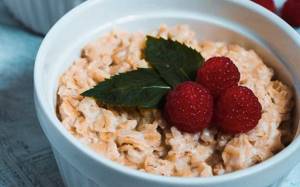
The benefits and harms of oatmeal, composition of vitamins and elements, properties
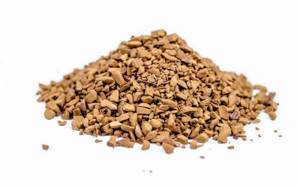
The benefits and harms of instant coffee

How to drink red wine correctly, benefits and harms
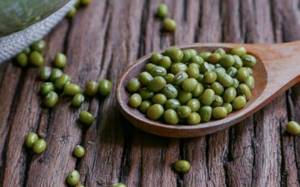
Benefits and harms of mung bean cereals, properties, how to prepare
Compound
The noodles contain:
- 75% of starch is from various plants, so its nutritional value is undeniable.
- Among other things, it includes the entire list of vitamins from group B, which has a beneficial effect on the state of the nervous system and cell metabolism.
- There is a high content of vitamins PP and E.
- Funchose contains a lot of micro and macroelements: sodium, phosphorus, potassium, magnesium, calcium and other useful minerals.
- It also contains saturated and unsaturated fatty acids and dietary fiber.
If we talk about calorie content, then funchose is a very high-calorie product. It contains 320 kcal per 100 g of dry noodles. During cooking, the noodles are saturated with water and their calorie content drops to 90 kcal for 100 g of product, which makes it a dietary dish that helps with weight loss.
It should be taken into account that the presented composition is designed for the traditional recipe for preparing noodles, without deviations in the direction of reducing the cost of the product.
Funose composition
Funchoza is rich in components that are quite common, but rarely found in one product. This is the main difference between noodles. It has the ability to strengthen all parts of the body, acting gently and for a long time. Eastern people know a lot about the benefits of products and carry the secrets through millennia.

Calcium and phosphorus in funchose
Two more important elements in funchose are calcium and phosphorus. Much has been said about the beneficial properties of calcium; it strengthens the inert system and tends to accumulate in the body, which is very important. There are harmful factors that, through their influence, wash calcium out of the body, so a supply of it will not hurt. Phosphorus is responsible for visual acuity; its deficiency gradually leads to a decrease in the ability to see. It is especially necessary for children at the time of growth and people at an age when all microelements and vitamins need replenishment.
Benefit
The composition of noodles indicates its nutritional value and benefits to the body. It affects the improvement of the functioning of various systems of the human body, where the following factors are distinguished:
- Improves the functioning of the gastrointestinal tract, since funchose is rich in fiber. Zinc, which is part of the product, removes waste and toxins from the body.
- Improving heart function and strengthening blood vessels, completely cleansing them and imparting elasticity due to the high content of potassium and magnesium in the composition.
- Complex carbohydrates, which are responsible for building muscle and tissue, help you lose weight while maintaining healthy muscle mass.
- Funchose replenishes the lack of amino acids in the body, which are needed to stimulate metabolic processes of a vitamin nature and at the cellular level.
- It is a natural antidepressant, helps stabilize the nervous system, improve performance, and develop resistance to stress.
- Vitamin E contained in the product can rejuvenate the body, thereby improving hair structure, reducing brittleness of nails, making the skin elastic and smooth.
- Phosphorus improves vision, and calcium is necessary to improve bone structure.
In addition, funchose does not contain allergens, therefore it is a safe product for people of all ages. It can be consumed by people with liver, kidney, and heart diseases, as a dietary product, if the sauces for it are low-fat and low-calorie.
Harm
Rice noodles are not recommended for frequent consumption by people suffering from constipation, because rice has a fixing property and rice starch is no exception. People with diabetes should not eat funchose due to its high starch content, which can lead to surges in blood sugar. It is important to remember that restaurant serving of noodles involves seasoning them with sauces, and some of them are very high in calories and are not beneficial for obese people. Therefore, they can enjoy funchose if it is served with vegetables and low-fat seasonings.
When buying noodles, you need to pay attention to the composition of the product. If it contains the addition of corn starch, then it is a low-quality product. It is safe to buy noodles in specialized oriental stores or departments. Vinegar and other seasonings for cooking are often offered here. It is not recommended to buy ready-made salads, since instead of exotic sauces they add regular vegetable oil, which makes the dish cheaper and less healthy.
Asian cuisine is considered one of the healthiest and most dietary, and also pleases with the speed of preparation and exoticism of its dishes, many of which occupy a leading position in their originality and usefulness, combined with low calorie content. Funchoza (glass noodles)
is one of those dishes.
How to prepare funchose? Delicious and quick salad recipe
As a rule, Asian cuisine is not very easy to prepare. You can start implementing recipes only after you already know what funchose is. It is not enough to cook bean vermicelli like regular pasta. However, the method of preparing funchose is usually indicated on its packaging. Dry vermicelli should be placed in a bowl, pour boiling water over it and leave in this form for 5 minutes. After the specified time, the liquid must be drained. If desired, funchose can be washed under running water.
Since bean vermicelli itself does not have a distinct taste, it is used as the main ingredient in salads or as a side dish, but only with the addition of a large amount of sauce.

Cut one large onion and large carrot into strips. In the same way, chop red bell pepper, large fresh cucumber and chicken fillet (200 g). Fry in a small amount of vegetable oil alternately: onion, fillet, carrots, pepper. Pour boiling water over the funchose. Combine fried meat and vegetables with prepared bean vermicelli, fresh cucumber and herbs. Add salt and pepper and let it brew for two hours so that the funchose is saturated with the taste and smell of vegetables and meat. Salad ready. Bon appetit!
History and description
Glass noodles came to us from Asia relatively recently; they are an important component of the main dishes of traditional Japanese, Chinese, Thai, Indian and Korean cuisines, where they have been consumed since the 6th century
. Thailand is considered the birthplace of funchose; it is known that it is an important element in the diet of Japanese ninjas.
Funchoza is a long white thread of round cross-section, the diameter of the threads varies, made from the starch of a special variety of golden mung beans; Looks very much like rice noodles.
To make funchose, starches from other plants are used:
- potato;
- Cannes;
- cassava;
- corn;
- beans.
However, they are less useful and valuable. When cooked, funchose becomes translucent, as if made of glass (which is why it got its second name).
Useful and medicinal properties of funchose
Glass noodles have a positive effect on the human body due to the high content of vitamins and microelements in its composition. Asians consider it one of the best sources of energy.
Funchoza contains fiber
, thanks to which it improves digestion, participates in the processes of cleansing the body of all kinds of toxins and wastes, with regular use it improves heart function and promotes the elasticity of blood vessels.
Glass noodles are a great antidepressant
, its proper use helps rejuvenate the body, improves brain activity, strengthens hair and nails. Funchose is completely free of protein and gluten, so it can be eaten even by allergy sufferers.
Is it possible to lose weight on funchose?
Nutritionists say that funchose can replace any side dish on a diet. The body is saturated with vitamins, and fat burning occurs faster when consumed.
Funchoza when losing weight - is it possible or not?
Glass noodles as a low-calorie side dish with the addition of poultry and vegetables speed up metabolism and enrich the body with energy. It has practically no side effects, is well absorbed, removes toxins and bad cholesterol. Losing weight is non-exhausting, reasonable, and, at the same time, fast. Nutritionists recommend that people losing weight not doubt whether funchose can be on a diet, but feel free to include it in their diet.
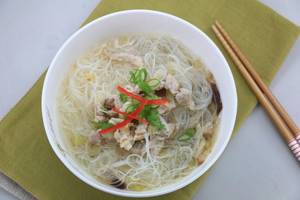
Chemical composition and calorie content of funchose
The composition of funchose is very rich in amino acids, vitamins and microelements. Amino acids
are very important for the human body, thanks to them many chemical processes take place, they are usually produced by the body itself, but their deficiency can always be replenished from the outside in order to normalize the process of cell rejuvenation and improve brain activity. The important chemical components of glass noodles are (per 100 grams of product):
How much protein, fat, carbohydrates (BJU) and calories are in funchose?
Funchoza in a healthy diet
Funchoza is easy to prepare, easily digestible, and provides a lot of energy; perfectly nourishes the body and removes toxins and waste; improves metabolism, bone tissue, vision, skin, hair and nails. Regular consumption of glass noodles improves potency in men and affects the functioning of the thyroid gland
, preventing cancer.
This is the perfect side dish
for fish, meat, vegetables, since the noodles themselves have no taste, and, accordingly, perfectly complement the taste of the dishes served with them. Glass noodles contain absolutely no cholesterol, so they are good for diabetics and hypertensive patients.
It is important to cook the noodles themselves correctly. To do this, before cooking, you should soak dry funchose in water for 10-20 minutes.
so that it swells, and then lower the noodles for 5-12 minutes (depending on thickness) in boiling water or broth. You can also steam glass noodles. The cooking method does not affect the nutritional properties of the product. You cannot store prepared noodles in broth or water, because... it becomes limp and spoils.
How and with what to use funchose to lose weight
Funchoza is perfect for anyone struggling with excess weight. Despite the high calorie content (320 kJ per 100 grams of product), glass noodles promote weight loss. The whole secret is that when cooked, funchose is saturated with water, resulting in a reduction in calorie content (up to 90 kJ per 100 grams of product).
This is an excellent sorbent
, which promotes proper cleansing of the intestines and the removal of harmful microelements and toxins. Funchose combines most harmoniously with dishes made from mushrooms, fish and seafood.
Combination with vegetables
does not cause heaviness to the gastrointestinal tract, but for those who want to lose weight, it is recommended to use it in the first half of the day, as well as dishes made from funchose in combination with meat.
If your goal is to lose excess weight, do not use hot spices in combination with funchose; they increase appetite and can lead to overeating.
How to choose the right one
Due to the popularity of the dish, there are many fakes “like funchose”, so you definitely need to pay attention to the country of origin and the composition of the glass noodles. The best funchose is imported from Thailand
. And the point is not that it is made there in some special way, it’s just that the kingdom’s products have a minimal percentage of fakes.
Funchoza from China
prohibited for import in some EU countries precisely because of the huge number of counterfeits containing harmful impurities, such as lead, which is used to bleach cheap varieties of funchose.
Proper noodles are made from the starch of golden mung beans
. Noodles made from other types of starch are less valuable (funchose based on soy and corn is the least valuable).
When choosing, you must pay attention to the packaging; it must be intact, without tears or holes (this is a natural product, so if the packaging is damaged, harmful microorganisms will happily settle in it). The product is made without the use of preservatives, so the shelf life of the noodles should be taken into account.
Funchoza looks very similar to rice noodles, but they are completely different things.
Storage Features
It is better to store purchased glass noodles in hermetically sealed glass or plastic containers in a dark, not necessarily cool, place. Unsealed storage can cause the noodles to spoil due to external moisture, and the sun's rays can destroy the structure of the product.
Step-by-step recipes
Korean noodles
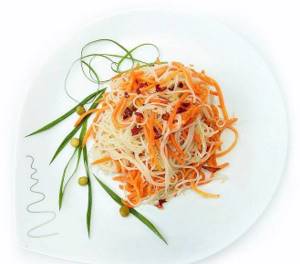
| Ingredients | Quantity |
| rice noodles - | one pack |
| carrots - | 3 pieces |
| garlic - | a pair of cloves |
| table vinegar - | 1 teaspoon |
| vegetable oil - | 100g |
| bell pepper - | one joke |
| salt - | taste |
| ground pepper - | taste |
| Cooking time: 25 minutes | Calorie content per 100 grams: 212 Kcal |
Article on the topic: How to quickly cook pudding in the microwave
Preparation:
- Pour water into a small saucepan and place over medium heat. After the water boils, add rice noodles to it. It should cook for about 7-10 minutes;
- Then we cook the vegetables. Carrots need to be washed well and cut into thin strips. You can also grate it on a coarse grater. Chopped carrots must be mixed with salt and given some time to steep. 7 minutes will be enough;
- Next, remove the seeds from the bell pepper and cut it into strips. The pepper pieces need to be fried in oil and placed on a sieve to drain off excess oil;
- Place the cooked noodles in a colander and rinse with cool water;
- Then mix it with carrots and add crushed garlic cloves. Mix everything well;
- At the end, add bell pepper, sprinkle with vinegar, salt and pepper. Mix everything again and leave for a while to let the salad infuse.
The same salad can be prepared with cucumber, as in the video below:
Harm and contraindications
No harmful effects of funchose on the body have been recorded, except perhaps individual intolerance to the product, which is extremely rare. It is not recommended to overuse glass noodles for people prone to constipation.
Funchoza is a very valuable product in dietary nutrition.
. The rich content of microelements and vitamins makes it an indispensable attribute of a healthy lifestyle. The nutritional value and the ability to quickly and easily saturate the body make this product economically profitable.
Do you use funchose? What original dishes do you prepare using glass noodles? Leave your recipes and reviews on our website and share information.
How is funchose prepared for weight loss and what is it? Funchoza is a starch noodle widely used in oriental dishes, although many people mistakenly think that this product is made from rice. Funchoza contains a huge amount of vitamins, such as: vitamin B, which promotes rapid metabolism in the body; E; PP, as well as many minerals vital to humans: manganese, magnesium, sodium, potassium, phosphorus, calcium, iron, selenium.
The main quality in starch noodles is that the dishes eaten do not contain gluten, a substance that is often the cause of food allergies. For older people, funchose is also a very good product, since thanks to the microelements it contains, it contributes to the vitality of the body. Funchose can be consumed even if you have diabetes, oncology, or cardiovascular diseases. Its calorie content is 320 kcal/100 g, proteins - 0.7, fats - 0.5, carbohydrates - 84.
Why are starch noodle dishes so attractive?
For those losing weight, funchose has become an ideal product, as it contains complex carbohydrates. When dieting with this product, the consumption of fats and sugar is reduced. It contains amino acids that are essential in the mechanism of cell renewal in the human body.
What improves noodles on a diet:
- activity of the nervous system;
- improves the structure of the skin;
- improves health, preserves youth;
- reduces glucose levels in diabetes mellitus;
- reduces the risk of vascular diseases;
- improves digestion and intestinal motility;
- strengthens bone tissue;
- maintains water-salt balance;
- normalizes kidney function.
Funchoza has almost no contraindications for use if it is prepared from high-quality products. If you have diabetes and other diseases, it is not advisable to overeat - it is harmful. To take advantage of all the benefits of funchose for weight loss, you need to learn how to cook it.
What is funchose
Thin rice noodles are increasingly used as a side dish during dieting. It has been proven that funchose for weight loss enhances the body's metabolic processes. This is due to the fact that the composition of glass noodles is about 20% resistant starch (which is not converted into glucose) remains in the intestines and becomes food for bacteria (fermentation process). By processing noodles, the body receives the necessary fatty acids, absorbs calcium and magnesium more easily, the level of glucose and cholesterol gradually decreases, and fat accumulations are “burned.”
Properties of glass noodles:
- vitamins B, D, macroelements;
- consists of complex carbohydrates that give a long-lasting feeling of fullness;
- amino acids contribute to the creation of new cells;
- no gluten;
- correct balance of BJU.
What is funchose made from?
Funchoza for weight loss is made from the starch of various East Asian plants, such as cassava, green mung beans, and quinoa. To reduce the cost of products, manufacturers are increasingly changing the composition of funchose: expensive starch from Chinese plants is replaced with cheap rice, potato or corn starch. Corn noodles can be distinguished only after cooking: they become white, and not transparent (crystal), like the original legume noodles. In addition, manufacturers of analogues add harmful zinc and aluminum to starch.
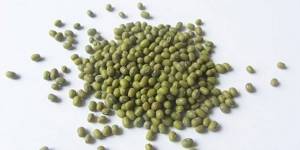
The benefits and harms of funchose
For people who want to lose weight and improve their health, rice noodles will become an indispensable assistant when losing weight, the main thing is to learn how to cook them correctly. The benefits and harms of funchose are described in the literature, but with proper preparation and selection of high-quality noodles, the negative consequences are leveled out, and nutritionists talk about its usefulness. You should not overeat if your body is weakened by chronic diseases. Since bean noodles are a side dish, pay close attention to the method of preparing them and the amount of spices, especially if you have problems with the gastrointestinal tract, or if you are cooking for a pregnant woman or nursing mother.
Beneficial properties of Chinese funchose for weight loss and PP:
- strengthening the nervous system;
- increasing skin elasticity, preserving its youth;
- decreased blood glucose in diabetes mellitus;
- reducing the risk of vascular diseases;
- improvement of the gastrointestinal tract, intestinal motility;
- strengthening bone tissue;
- maintains the water-salt balance of the body.
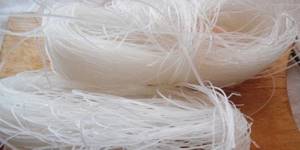
Calorie content
Starch noodles in dry form have a calorie content of 320 kcal/100 grams, in boiled form - 82 kcal/100 grams, with a low glycemic index (the rate of absorption of carbohydrates). Is funchose high in calories? Bean noodles themselves are a dietary product because they have minimal fat content. In rare cases, manufacturers add soy or buckwheat, but this has virtually no effect on calorie content or taste. Although the calorie content of funchose is high, it is recommended for overweight people, since it is made from bean flour, which does not harm the figure.
Energy value, KBJU, content of vitamins and macroelements in glass noodles:
Source
How to cook noodles?
It is advisable not to digest funchose during heat treatment, as it can become sour and lose all its properties.
But even if undercooked, it will stick to your teeth. So you need to cook it correctly: place it in a saucepan, add warm water and leave for 10 minutes. During this time it will swell. After this, you need to put a container of water on the fire, add salt and wait for it to boil. When the water boils, put the swollen noodles in it for 5-10 minutes.
It is also necessary to mention that it is not recommended to combine funchose with potatoes, since it is filling in itself, and it is not recommended to combine it with meat: pork, beef and lamb. Funchose should be consumed exclusively for breakfast or lunch. If you follow these rules, then noodles will not harm your figure, but rather will release all the beneficial vitamins into your body as much as possible.
Nowadays, funchose can be purchased in any grocery stores and supermarkets. But this does not mean that you can buy real noodles. Finding a real product of good quality is difficult. You need to be more careful when choosing a product. There are some tips on how to buy the best quality weight loss noodles:
- Dry funchose should have a uniform color (transparent).
- If the noodles are white, then they are made from low-quality products.
Funchoza is an important ingredient for vegetarian and lenten cuisine, as it has always been a plant product, completely natural. It absorbs all smells and tastes very well, so it can be used as a side dish for meat, fish, and vegetables. It is also used in first and second courses, in salads and soups. You can combine these noodles with chicken. Salads with funchose should be served warm. If served cold, the noodles may stick together and lose their attractive appearance.
Funchoza has virtually no taste, but when combined with other products, you can get new tastes. It cannot be eaten separately, and when consumed it is better not to add salt. Usually only the sauce that is served with the noodles is salted. It must be remembered that sauces containing fatty substances can harm the body, thereby reducing to zero all the beneficial properties of funchose for weight loss.
From all of the above it follows that starch noodles can become an indispensable companion in the life of a person on a diet. The main thing is to prepare it correctly, preserving all the beneficial properties of the product. Be healthy!
Winter, ice, “glass” or “starch” noodles are all names for the same exotic product. Funchoza... Today this dish is popular not only in Asia, but also in Europe. In Chinese, “fensi” means “string of noodles.” What is this product made from and is funchose useful for weight loss? How many kilocalories are in 100 g of noodles and can you gain weight from eating them? We will try to answer all these and other questions in our article.
How to cook funchose at home - the best ways
Funchoza is a universal basis for kitchen experiments. Cooking it is as easy as shelling pears, and you can serve it in various ways: as a main dish, as a side dish, as an independent dish, or as an ingredient in a salad.
I have selected several hearty and healthy dishes that are easy to prepare. They will add variety to the diet, delight you with a new taste, brightness, and unusual appearance.
How to cook funchose with chicken - recipe
There is nothing complicated, the ingredients are accessible, but there are a couple of nuances. They need to be taken into account.
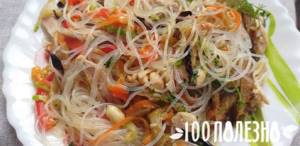
First, wash the vegetables. Any kind will do (for example, eggplants or turnips), not just the ones I listed. Then soak the Chinese vermicelli for a minute, put it in a colander, and after a quarter of an hour, cut it with scissors. If this is not done, then after cooking it will be difficult to mix with the rest of the ingredients.
For 4-5 small servings you will need:
- funchose – 200 grams,
- chicken fillet – 350 g,
- small carrots,
- bell pepper,
- half a young zucchini
- Chinese cabbage (or young white cabbage) – 100-200 grams,
- roasted peanuts - 3 tablespoons,
- a bunch of your favorite greens,
- 2 eggs,
- salt,
- soy sauce,
- sesame oil – 1 tbsp. l. (for aroma)
- refined vegetable oil for frying,
- garlic – 2-3 cloves,
- deep frying pan or small cauldron.
Cook at medium boil without a lid. Less salt is required than usual. Soy sauce adds spiciness.
Funchoza with chicken and vegetables - how to cook:
- Cut the chicken into thin strips (like beef stroganoff). Dry thoroughly on a paper towel.
- Pour vegetable oil into a frying pan and heat it up very high.
- Fry the chicken until done. The smaller the slices, the less time it will take. Focus on the appearance of a golden crust and clear juice when pressed.
- Add strips of carrots and pepper.
- After a minute, pour in the diced cabbage.
- After 2 minutes, throw in thin slices of zucchini.
- Fry for a minute, add crushed peanuts.
- Remove from heat.
- Separately, beat the eggs and fry like an omelette.
- Divide into arbitrary pieces and transfer to a frying pan.
- Season with sauce - 0.5 teaspoons per serving.
After this, cook and wash the noodles. Then combine with chicken, sprinkle with chopped herbs.
An important point is that the vegetable components are slightly undercooked. They should crunch slightly inside. But fry the chicken completely. Half-raw meat is dangerous to health.
Funchoza with chicken is a bright, satisfying appetizer. If desired, add fresh or dried ginger and sprinkle with sesame seeds. They will add even more Asian notes.
How to cook funchose with vegetables in Korean
This is a cold option. It is served as a salad or appetizer. It takes a few minutes to prepare and looks like something out of a restaurant.
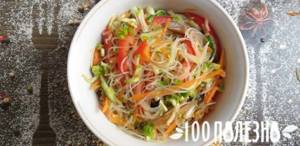
We will need:
- eggplant – 1 pc.,
- sweet meaty pepper,
- small carrot,
- funchose – 150 grams,
- radish - slice,
- pickled wild garlic – 6 pieces (if not, a cucumber will do),
- half a bunch of parsley
- Korean dressing from the supermarket.
What to do:
- Wash the vegetables thoroughly, peel (if necessary), and chop. We try to get long sticks that resemble KFC fries.
- Quickly fry the blue ones until golden brown.
- From grated carrots we make “Korean style carrots”. To do this, pour it with hot oil (1 tbsp), quickly mix with crushed cloves of garlic and 0.5 teaspoon of vinegar.
- Place boiled noodles in a deep bowl.
- Once it cools down, throw in the vegetables.
- Salt and pour out the sauce. This is the main ingredient, but try not to overdo it.
- Pour in chopped herbs.
- Mix thoroughly.
- Let it sit in the refrigerator for half an hour.
Fried funchoza – my favorite
This is a simple but effective side dish that doesn't require any company. Prepares instantly. It can be successfully complemented with anything - fish, squid, shrimp. I like it without anything.

Preparation procedure:
- Pour boiling water over the “skein” of funchose.
- After a couple of moments, drain the water.
- Heat oil in a frying pan (1-1.5 tbsp.).
- Throw in the crushed garlic clove.
- Lay out the noodles.
- Season with soy sauce (or don't).
- Fry for 2-3 minutes, then carefully turn over with a spatula.
- Continue cooking the same amount.
- Remove from heat.
When serving, sprinkle with toasted sesame seeds or chopped herbs.
Composition of “glass noodles”: what are they made of?
This food product is produced from mung bean starch. They resemble green peas. These beans are mainly grown in India.
Funchoza began its march around the world from China, which is why many consider it the national dish of the Celestial Empire. Although Japan and Korea can equally claim the title of homeland of this delicacy.
Sometimes potato, rice or yam starch is used for production, but, of course, this is no longer the original product. In supermarkets, real “glass” mung bean noodles are much more expensive than fake ones.
What is the difference between rice noodles and funchoza?
Many people consider rice noodles and funchose to be the same thing, but this is a big misconception.
1. Rice noodles are made from rice flour, and funchose is made from starch.
2. Rice noodles have a rich white color, which remains the same when cooked, unlike funchose, which is completely transparent.
Based on these facts, you can understand that these products are completely different things, I hope you will never confuse them again.
What does this dish taste like?
Funchoza - Traditional Chinese Noodles
Funchoza is often called "noodles without taste." It doesn't look like pasta or spaghetti. Externally, dry noodles look like long white threads of different diameters, rolled into a ring. When cooked, it becomes quite unusual in appearance - translucent, “glassy”. And it looks like a great glass blower's job. In traditional Chinese cuisine, it is served with hot and sweet and sour sauces and dressings. This combination complements the taste of fish and meat well.
How many calories are in boiled funchose?
If consumed correctly, this product will help you get rid of extra pounds (the calorie content of funchose in its finished form is 81 kcal per 100 g). Spices, herbs, sauces and other additives increase the calorie content of bean noodles.
You may be interested in learning about the benefits and harms of soy asparagus. Read more details
How to use correctly, in what doses
You can diversify your menu with funchose 2-3 times a week. It is better to eat in small doses, the best time will be the first half of the day. Remember that once pasta gets into the water, it becomes less caloric, so even those who are on a diet can sometimes boil it.
The main thing is to adhere to measures so as not to cause stomach upset.
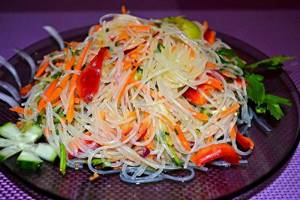
Funchoza is intended for various dishes that you can prepare yourself at home. For restaurants and cafes, this is not the main product in the diet, but a component for hot and cold vegetable salads, fish and meat dishes. Can be used as a light side dish, eaten with seafood and mushrooms.
We recommend reading: Beneficial properties of nutmeg, how to use it, effect on the body
It is often used as an addition to first courses. It goes well with hot and spicy dishes and takes on the aromas of spice. Used by restaurants and cafes that offer oriental cuisine. It is important to be careful when choosing and using, then you will successfully join Asian cuisine.
Funchose should be cooked for 3-5 minutes. The finished dish goes well with soy sauce. It is interesting to know that this vermicelli springs back on the teeth.
Composition and beneficial properties
The composition contains many useful substances; they ensure the full functioning of all organs. It is enough to use the product 1-2 times a week. This helps to improve the health of the body. It is important to remember that it contains little dietary fiber and virtually no amino acids or proteins. You need to think through your menu well.
Composition of real funchose:
- minerals (iron, selenium, manganese, zinc, sodium, potassium, copper, magnesium, phosphorus);
- tocopherol (E) and B vitamins: thiamine (aneurin), folic acid (B9), riboflavin (B2), nicotinic acid, pyrodoxine;
- polyunsaturated and saturated fatty acids.
Is there gluten in the food? Real mung bean noodles do not contain gluten, a protein that is dangerous for allergy sufferers.
Is funchose beneficial or harmful for older people? Due to the lack of fiber in the composition, doctors recommend that older people also take it. It is easily digestible. It can be added to soups and side dishes.
Funchoza for diabetics: is it harmful?
The glycemic index of funchose is 45 units. Diabetics can safely include funchose in their diet. The product has virtually no effect on glucose levels. Bean noodles are a very nutritious dish (85% of the composition is carbohydrates). Restores the supply of nutrients in the body, improves mood. Reduces the risk of developing diabetic foot, thrombophlebitis, stroke and heart attack.
Is funchoza high in calories or not? How many carbohydrates does it have?
The energy value of funchose is 320 Kcal per 100 g of product in dry form. Proteins, fats and carbohydrates in 100 grams are present in amounts of 0.7 g, 0.4 g and 84 g, respectively.
How is it useful?
The healing properties of the Asian product lie in its vitamin and mineral composition. Eating this delicacy promotes:
- cleaning from harmful and toxic substances;
- normalizing blood sugar levels;
- regeneration of skin cells and nerve tissues;
- improving the functioning of the gastrointestinal tract;
- strengthening bone tissue;
- normalization of the psyche;
- replenishing oxygen to body cells;
- reducing the risk of developing cancer.
You will learn more about the benefits of funchose from the video:
Is funchose suitable for pregnant women and nursing mothers? There are no contraindications to the use of funchose during pregnancy. Thanks to its rich composition of vitamins and microelements, it has a beneficial effect on fetal development. The main thing is not to overdo it with hot sauces and spices. In case of breastfeeding, it is better to use “starchy noodles” for preparing salads, light soups, and side dishes. It is also recommended that hypertensive patients and heart patients include noodles in their diet.
Does funchoza help you lose weight?
Funchoza or “glass” noodles are prepared from the starches of various plants - peas, potatoes, corn and mung beans. Most of the starch in funchose is resistant starch
. Resistant starch, unlike regular starch, increases insulin sensitivity, lowers blood sugar and improves metabolism.
Resistant starch can help you lose weight - it is very satiating and you eat less.
Resistant starch also has a “second meal effect,” meaning that if you eat resistant starch for lunch, it will lower your blood sugar at dinner.
Low insulin sensitivity is considered a major causative factor in type 2 diabetes, obesity, cardiovascular disease, Alzheimer's disease and metabolic syndrome.
The effect of resistant starch on glucose and insulin metabolism is quite impressive: after 4 weeks of consumption of 15-30 g per day, a 33-50% improvement in insulin sensitivity was found.
Resistant starch significantly improves digestion, the health of intestinal flora and helps prevent colon cancer.
Funchose salad with fresh vegetables:
Other sources of resistant starch are legumes - beans, peas and lentils, barley and oats.
Healthy lentil salad:
Salad with beans and tuna:
Oatmeal for breakfast:
See you again! Your "Healthy Food"
Source
Contraindications: beneficial or harmful?
The product itself, made from legumes, has no contraindications. But it happens that, wanting to save on ingredients, manufacturers use different substitutes. They are often harmful to health. When buying noodles, pay attention to the composition. If it contains chemical additives, rice starch, then such a product will not bring any benefit (especially to diabetics). Corn starch reduces the taste of noodles. Those who suffer from intestinal obstruction and constipation should eat this dish with caution. Unscrupulous manufacturers use lead to bleach noodles; this can cause poisoning or even death.
It is not recommended to eat funchose daily. Otherwise, in a week or two you can gain a couple of extra pounds. The noodles are very filling, just eat a small portion. Otherwise, you will have no appetite for fruits, vegetables, grains, and meat. The body cannot be deprived of all necessary proteins, microelements, and vitamins. Therefore, it is better to choose noodle recipes with lots of fruits and vegetables. How many calories are in funchose with vegetables? The nutritional value of the dish depends on the ingredients chosen, on average it is 170 kcal per 100 g.
How to choose funchose?
Recommendations for choosing noodles are quite simple:
- Vermicelli should be purchased at large chain markets or specialized outlets. The likelihood of purchasing a fake there is lower than from small sellers.
- High-quality noodles are not cheap, due to the high cost of real mung beans. The low price should raise suspicions; perhaps the funchose is made from corn starch.
- The composition on the label must be translated into Russian. This is the only way to study the ingredients included in the product.
A careful study of the composition and expiration date will allow you to purchase a quality product without worrying about your health.
Funchoza for weight loss: is it possible or not?
Let's find out whether it is possible to eat funchose while losing weight; will the calorie content of “ice noodles” hinder those who want to get in shape?
Anyone who has ever tried to lose weight knows firsthand how difficult it is to choose the right diet and diversify the diet menu. Many people prefer the famous Dukan protein diet. And lovers of Asian cuisine have a question: “Is it possible to eat funchose while losing weight and is it good for the body?”
How many calories are in boiled funchose? Is it possible to lose weight with “Thai paste”? After heat treatment, the nutritional value of the product changes. Boiled funchoza has less calories than its dry form. And with turkey, mushrooms or seafood, the calorie content of the dish does not exceed 160 kcal. Is it possible to eat this dish at night? It contains a lot of complex carbohydrates, so you can safely eat it in reasonable quantities before bed, and for breakfast, lunch and snack.
Is it possible to lose weight with funchose?
Funchoza is definitely a product that has a place in the diet of those who want to lose weight. It can be prepared as a side dish for meat and fish dishes or become the main ingredient in an unusual and nutritious salad.
There are thousands of different recipes using funchose in world cuisines. It can be supplemented with oriental spices and herbs, sour, sweet and hot sauces, or used independently.
The main advantage of glass noodles is that they are a “blank slate”, that is, the options for combining them with different food products are limited only by your imagination and wallet.
With the help of this flour product, you can diversify your diet, providing yourself with energy, a complex of useful elements and noticeable satiety. Enriching your diet with such low-calorie and at the same time nutritious foods as funchose is one of the ways to control weight. But, of course, without regular exercise, losing weight with just one food item will be difficult.
Benefits and harms of diet
Is funchoza a dietary product or not? We can say that “glass noodles” are a dietary food. The minimum fat content in the product will help in the fight against excess weight. When losing weight, the effect of including boiled funchose in the diet will be more pronounced if it is consumed without fatty sauces.
Can these noodles be used on the Dukan diet? It is known that the diet consists of 4 stages. On the first two, you can’t eat funchose. At the third stage - twice a week in finished form. No more than 125 g per meal. For this purpose, special days are introduced: Feast days and 2 days when you can eat foods that contain starch. In the fourth phase of the diet, funchose can be consumed little by little on all days except Thursday. The benefits of the product when losing weight will be noticeable, since it is an ideal assistant for people who want to have healthy muscle mass.
We have already found out whether funchose contains calories. There are many recipes online where the main component of the dish is noodles. If in doubt, you can seek advice from a nutritionist. He will help with choosing a diet and counting calories.
You will learn an interesting and useful recipe for making funchose from the video:
EAT FUNCHOSE TO LOSE WEIGHT!
You won’t even notice how much weight you’ll lose! This delicious diet food will allow you to lose weight without effort and labor!
Dear friends! In this article I will give a simple example of a recipe for a hearty and healthy dish with funchoza noodles. Funchoza is a very low-calorie and tasty noodle, so you won’t even feel like you’re on a diet or following proper nutrition!
So, we need for 2 servings:
-1/4 part of a package of funchoza noodles
-100g beef or chicken fillet
-salt and pepper to taste, you can also have dried garlic and celery, it won’t be too much
